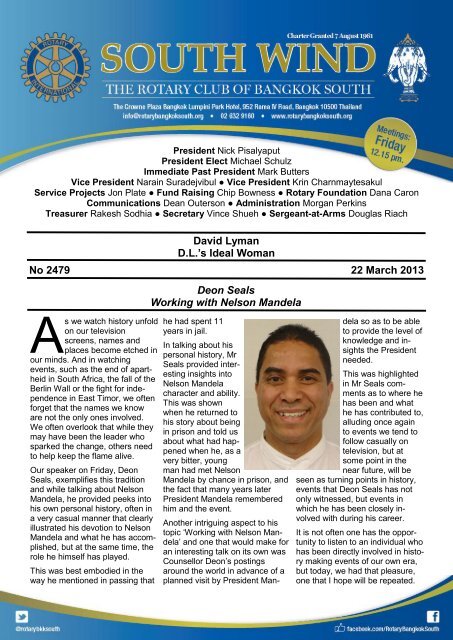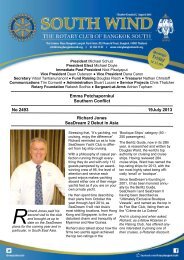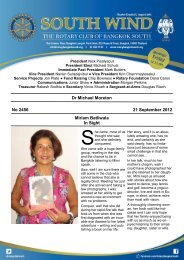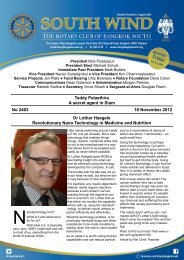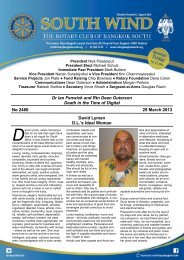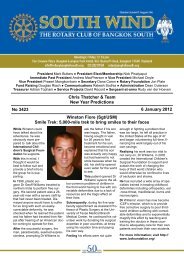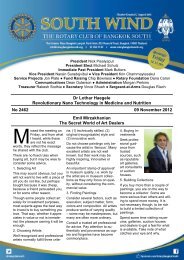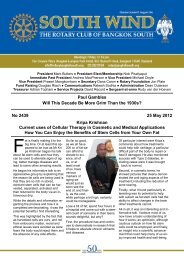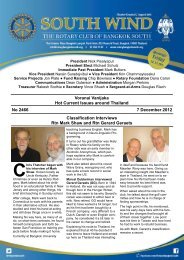Deon Seals Working with Nelson Mandela David Lyman DL's Ideal ...
Deon Seals Working with Nelson Mandela David Lyman DL's Ideal ...
Deon Seals Working with Nelson Mandela David Lyman DL's Ideal ...
- No tags were found...
You also want an ePaper? Increase the reach of your titles
YUMPU automatically turns print PDFs into web optimized ePapers that Google loves.
President Nick PisalyaputPresident Elect Michael SchulzImmediate Past President Mark ButtersVice President Narain Suradejvibul ● Vice President Krin CharnmaytesakulService Projects Jon Plate ● Fund Raising Chip Bowness ● Rotary Foundation Dana CaronCommunications Dean Outerson ● Administration Morgan PerkinsTreasurer Rakesh Sodhia ● Secretary Vince Shueh ● Sergeant-at-Arms Douglas RiachNo 2479<strong>David</strong> <strong>Lyman</strong>D.L.’s <strong>Ideal</strong> Woman22 March 2013As we watch history unfoldon our televisionscreens, names andplaces become etched inour minds. And in watchingevents, such as the end of apartheidin South Africa, the fall of theBerlin Wall or the fight for independencein East Timor, we oftenforget that the names we knoware not the only ones involved.We often overlook that while theymay have been the leader whosparked the change, others needto help keep the flame alive.Our speaker on Friday, <strong>Deon</strong><strong>Seals</strong>, exemplifies this traditionand while talking about <strong>Nelson</strong><strong>Mandela</strong>, he provided peeks intohis own personal history, often ina very casual manner that clearlyillustrated his devotion to <strong>Nelson</strong><strong>Mandela</strong> and what he has accomplished,but at the same time, therole he himself has played.This was best embodied in theway he mentioned in passing that<strong>Deon</strong> <strong>Seals</strong><strong>Working</strong> <strong>with</strong> <strong>Nelson</strong> <strong>Mandela</strong>he had spent 11years in jail.In talking about hispersonal history, Mr<strong>Seals</strong> provided interestinginsights into<strong>Nelson</strong> <strong>Mandela</strong>character and ability.This was shownwhen he returned tohis story about beingin prison and told usabout what had happenedwhen he, as avery bitter, youngman had met <strong>Nelson</strong><strong>Mandela</strong> by chance in prison, andthe fact that many years laterPresident <strong>Mandela</strong> rememberedhim and the event.Another intriguing aspect to histopic ‘<strong>Working</strong> <strong>with</strong> <strong>Nelson</strong> <strong>Mandela</strong>’and one that would make foran interesting talk on its own wasCounsellor <strong>Deon</strong>’s postingsaround the world in advance of aplanned visit by President <strong>Mandela</strong>so as to be ableto provide the level ofknowledge and insightsthe Presidentneeded.This was highlightedin Mr <strong>Seals</strong> commentsas to where hehas been and whathe has contributed to,alluding once againto events we tend tofollow casually ontelevision, but atsome point in thenear future, will beseen as turning points in history,events that <strong>Deon</strong> <strong>Seals</strong> has notonly witnessed, but events inwhich he has been closely involved<strong>with</strong> during his career.It is not often one has the opportunityto listen to an individual whohas been directly involved in historymaking events of our own era,but today, we had that pleasure,one that I hope will be repeated.
flange. Energy dissipation is provided by supplemental elements that deform under the gap opening behavior.The gap opening behavior also causes the SC-MRF to expand, where in the deformed positionthe distance between the column centerlines increases relative to the original distance.While all the research on SC-MRFs shows potential to be an effective system in high-risk seismiczones, analytic modeling of the structures have differed. Some use a comprehensive model that explicitallysimulates the opening and closing of the gap using gap or fiber elements (Ricles et al., 2001;Garlock, 2002; Rojas et al., 2005). Others have taken a simplified approach, reducing the connectionbehavior (including the gap opening and closing, energy dissipation, and post-tensioning) to a rotationalspring <strong>with</strong> a moment-rotation curve consistent <strong>with</strong> the connection’s flag-shaped hysteretic behavior(Christopoulos et al., 2002a; Tsai et al., 2005). This approach has been used by others studying precastprestressed concrete frames that also exhibit this gap opening behavior (Priestley et al., 1999). This paperinvestigates these two modeling methods, notes the advantages and disadvantages to each, and proposessituations where each technique is appropriate.SC-MRF BehaviorA typical SC-MRF floor elevation and connection detail are shown in Figure 1. An SC-MRF connectionconsists of a post-tensioning system (e.g. high-strength steel strands or steel bars) that run parallelto the beam and compress the beam against the column flange. If properly designed the beam andcolumn remain essentially elastic during a strong ground motion. Hysteretic energy is dissipated viaother means such as top and seat angles (Ricles et al., 2001; Garlock et al., 2005), an energy dissipatingwelded bar (Christopoulos et al., 2002b), friction (Rojas et al., 2005; Wolski et al., 2005) or some otherenergy dissipating device (Chou et al., 2006). A shim plate is placed between the top and seat angles,extending between the beam and column, and provide a surface for the beam flanges to bear on thecolumn. Additionally, the beams are reinforced <strong>with</strong> plates that are shop welded to the flange. Posttensioningstrands are then anchored at each end of the frame, and the system is post-tensioned. It shouldbe noted that the figures in this paper show connections using top and seat angles as ED devices, but thediscussions of this paper apply to other ED devices as well.Under lateral loading, the SC-MRF connection behaves in a flag-shaped hysteretic manner (Figure2(a)). Initially the connection acts rigidly, <strong>with</strong> no relative rotation (θ r ) between the beam and column(path 0 to 1 in Figure 2(a)). Once the moment in the connection exceeds the moment in the strands,decompression occurs, and a gap develops between the beam and column (path 1 to 2 in Figure 2(a)).This gap is labeled ∆ gap in Figure 2(b). The next even to occur (point 2) is yielding of the energydissipation device. Once full ED yielding takes place (point 3), the connection will deform in a linearmanner until the limit state of strand yielding takes place (point 5), or unloading occurs (point 4). In thecase of unloading, the connection will act along the path from (point 4) until the beam makes contact<strong>with</strong> the column (point 8). Under reversed loading, in the case of ED devices such as top and seat anglesor welded bars, the hysteresis will be symmetrical as shown in Figure 2(a).The opening of the gap causes not only a local expansion in the connection, but an expansion of theentire frame as shown in Figure 3. Assuming ∆ gap of each connection is unrestrained and the same ineach bay, the bay expands a distance n c ∆ gap /2 from the center of the frame to the point of reference,where n c is the number of connections between the center of the frame and the point of reference.This expanding nature of the SC-MRF frame requires that flexible “collector” elements transfer thefloor inertia forces (f if ) from the floor to the SC-MRF frame. Figure 3 shows a collector beam approachfor transferring these forces (Garlock et al., 2006). Currently, research is being conducted on other typesof collectors for this system. The flexibility of these collectors induce additional axial forces in the beams(f cb ) as shown in Figure 3. These axial forces increase towards the center of the frame.In a SC-MRF, the beams develop a significant amount of axial forces, which are comprised of thefollowing (see Garlock et al. (2006) for more details):1. Initial post-tensioning force (T o )2. Additional post-tensioning force due to strand elongation (∆T ), which develops from ∆ gap
From Start to Finish, it was a great day!!!
Khun Khob’s Club Almanac # 2479 – 22 March 2013Attendance for 15 March 2013: 69%Present 44, Make-up 8, Absent 23,Exemption 28, Total 103Visiting on 15 March 2013From Local ClubRC Bangkapi Brent Clegg, Satpal SachdevRC Bangkok PP Ateeb MaskatiFrom AbroadJohn ChirgwinJohn MillingtonMale MillingtonInvited GuestsCarl Turner<strong>David</strong> ArmstrongPP Graham BrianGreg LaingJan AkermanJan TarkowskiRC Martha’s Vineyard, USARC North Hill, AustraliaRC North Hill, AustraliaIntroduced byChip BownessIPP Mark ButtersPE Mike SchultzRon LivingstonStuart LucaniChip BownessRecent MakeupsRC Jomtien-Pattaya, 13/03/13: Doug RiachMake-up CreditsHelmets for Children, 6/03/13: Ben Ferguson, Jon Plate,PE Mike Schultz, P Nick PisalyaputHelmets for Children, 8/03/13: Ben Ferguson, Chip Bowness,P Nick PisalyaputFundraising, 8/03/13: Chip Bowness, Doug Riach, PPJohn Quarmby, Stuart Lucani, Tyrone JenkinsProgram, 12/03/13: Alastair Timblick, AG Andrew Mac-Pherson, Chris Thatcher, Colin Hastings, Dana Caron, PPDon Lavoie, IPP Mark Butters, PP Nart Liucharoen, P NickPisalyaput, Paul Russell, Prasobsook Thawilvejjakul, PPRenato Porzio, Rick SmithTRF, 13/03/13: AG Andrew MacPherson, Dana Caron, KrinCharnmaytesakul, PP Krit Wongsaengarunsri, Pichai Kanivichaporn,Rod Vergara, Rui Belo, PP Vichai TantrativudAdmin, 14/03/13: Dana Caron, Morgan PerkinsService Projects, 15/03/13: Adrian Topham, Arie Bloed,Ben Ferguson, Chip Bowness, Doug Riach, Ian Morris, PPJohn Quarmby, Stuart LucaniClub CalendarFriday, 29 MarchDr Ian FenwickRtn Dean OutersonDeath in the Time of SocialMediaFriday, 5 AprilDoug RheinWomen incarcerated inThailandFriday, 12 AprilNO MEETINGFriday, 19 AprilCraig CraftAsia Injury Prevention FoundationFriday, 26 AprilStu LloydThai Military HistoryFor Bangkok South Eventsrotarybangkoksouth.org/calendar-of-eventsImportant Dates toRememberSaturday, 29 June 2013Installation DinnerDusit Thani Hotel


